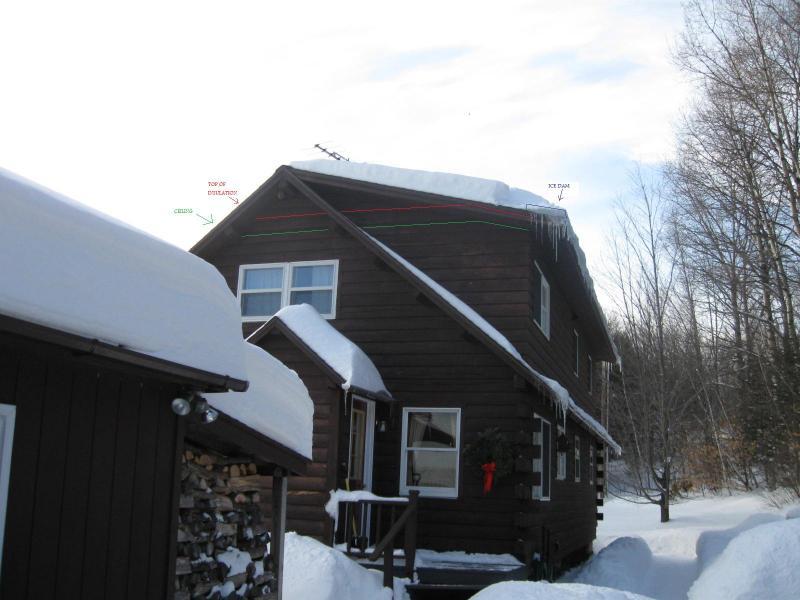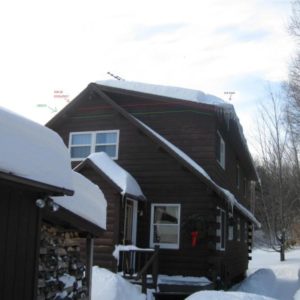I need some advice on ice dams and icicles we’ve been having since we added a shed dormer to our Vermont log home. The problem is that because of the height of the ceiling and pitch of the roof, there isn’t much space for insulation out towards the wall on the back side. The attic is ventilated with ridge and soffit vents. There are styrofoam baffles which take up some of the limited space towards the outside wall. Basically, I have R19 fiberglass between the ceiling joists, and where ther was space, I ran a second R19 layer crosswise. Since we get water dripping and forming icicles even in 20 degree weather, there either isn’t enough insulation, or enough ventillation. Of course, the ridge vent is pretty useless under a foot of snow. Oh, and the chimney runs up through the center of the attic.
I’ve attached a photo which shows the aproximate level of insulation (red) and the ceiling (green). I’d appraciate any thoughts on whether I should concentrate on better ventilation or insulation. Not enough room for gable vents, especially since the end walls are bearing the weight of the ridge beam.
Thanks




















Replies
I can't in the picture see the soffit vents. There should be at least 6 rectangular 8x16 vents, or continuous vent, with some sort of channels/baffles to keep insulation from interfering. The baffles need to be arranged so that they provide clear passage of air from vents to the larger attic, not simply "sorta" connected.
There is a continuous soffit vent under the overhang on the longest side. That would be probably 2 inches by 38 ft. Between each 2x12 rafter, there are styrofoam channels to hold back the insulation and provide a clear channel for air. I installed these myself and was careful not to compress or block them when laying in the insulation. These channels are another reason that there is so little insulation in that area of the cap. Between the channels and the low pitch of the roof, space was limited.
Can you tell where the actual melting is occurring? (You might be able to judge this by noting where the snow disappears first on the roof.) If it's melting up fairly high, above where your red line intersects, then the problem is poor ventillation. If it's melting below that point first, closer to the tails, then poor insulation is at least partly to blame.
But of course you can finesse the problem to a degree by installing heating cables. (Though maintaining them is a PITA, especially that high up.)
The only time I've noticed any difinitive source is when running the wood stove. The stove is located near the base of the stairs and too much heat goes up the stairwell. Then you see snow melting near the chimney. I had the roof reshingled this year and had them put Grace ice and water shield over the entire roof. Also put a metal snow belt along the edge. Hopefully that will prevent/minimize water entering the house, but I'd like to get a handle on this.
How well sealed is the attic from the conditioned space? Any pot lights poking into the attic? Is the chimney sealed to the ceiling? Air leaks are more of a problem than lack of insulation.
Asymetric roofs do not always vent equally on both sides. Orientation of the roof also has an affect. Looking at the shadows, I'm assuming the new dormer is on the north side. With the steep front roof sheding snow much faster that the dormer roof, sun will warm up exposed roof on that side. Unless the two roof have separate attic spaces. that warm air from the front will melt the snow on the dormer. It also looks like the vent is half covered with snow, blocking much of the ventilation.
I would first see if it possible to separate the ventilation of the front roof and the dormer, and install separate vents for each side. For the dormer side, a cupola style vent tall enough to sit above the snow depth would be best. If separation is not possible, increasing the vent area at the ridge may be required to ensure that air is being drawn from the dormer soffits. You may have to block some of the front soffit vents as well, to balance the air flow.
These are popular in the snow bound parts of eastern Canada. I have them on my home. They work well. Maximum Ventilators
Good point about the orientation. I see this to a degree on our house, when the sun hits the south side, though not as bad as in the pictures above.
In the worst case a power vent might be required, but air sealing and partitioning the attic (a simple sheet of Tyvek will do) could go a long way.
You make some good points. The chimney has fiberglass insulation laid against it in the attic. Two sides of the chimney are accessible from an upstairs closet, and have been sealed. The other two sides are behind a wall and I honestly can't remember what they look like.
I have wondered about the inpact of the steeper southern roof. It's a "cold roof" constrution. Before constructing the dormer, both sides of the roof were built this way. Originally the upstairs was more of a loft with exposed perlins up to the peak....sort of a cathedral ceiling. T&G boards laid across the perlins, then a layer of foam board insulation, an air space, the the roof sheathing. The steeper southern roof retains that construction, so basically it has internal ventillation and *some* insulation.
The newer northern roof is conventional construction the roof sheathing laid over 2x12's. The way they mate at the ridge is not glamorous. The contractor nailed a 2x12 to the original ridge beam, protruding a couple of inches. This had small vent holes drilled in it. I questioned him about the small holes, and he assured me they were sufficient. {The contractor only did the shell, I did the finish work) After he left, I drilled larger holes, and doubled the amount of them. They still aren't equal to the open vents on the cold roof, but aren't they two separate sustems? Still, I've always worried that the capacity of the ridge vent is less than the soffit. It's sufficient for condensation, but maybe not for cooling.
The Maximum Ventilators in your link look interesting. Looking at the specs, they'd be okay until I got more than 14" of snow. I also have wondered about putting some small vents in the end walls of the dormer. There isn't much clearance, but it's half log siding rather than the solid logs at the peak. Would that help, or intefere with the soffit/ridge system, I wonder?
UPDATE:
Warm day today with a lot of melting. It's now possible to see that while there is still a lot of snow on the roof, there is a radius of bare roof around the chimney / top of stairwell. The chimney is starting to look real guilty. It's not going to be easy to access, but I think that needs attention. Thanks you and Dan H for the pointers.
The junction between the wall and eaves is the most critical spot to insulate well. Your problem is that there just isn't room for enough fiberglass insulation there to stop air flow. I think your only option is to pull the drywall down at the edge and have as much closed cell spray foam blow in as they can get in.